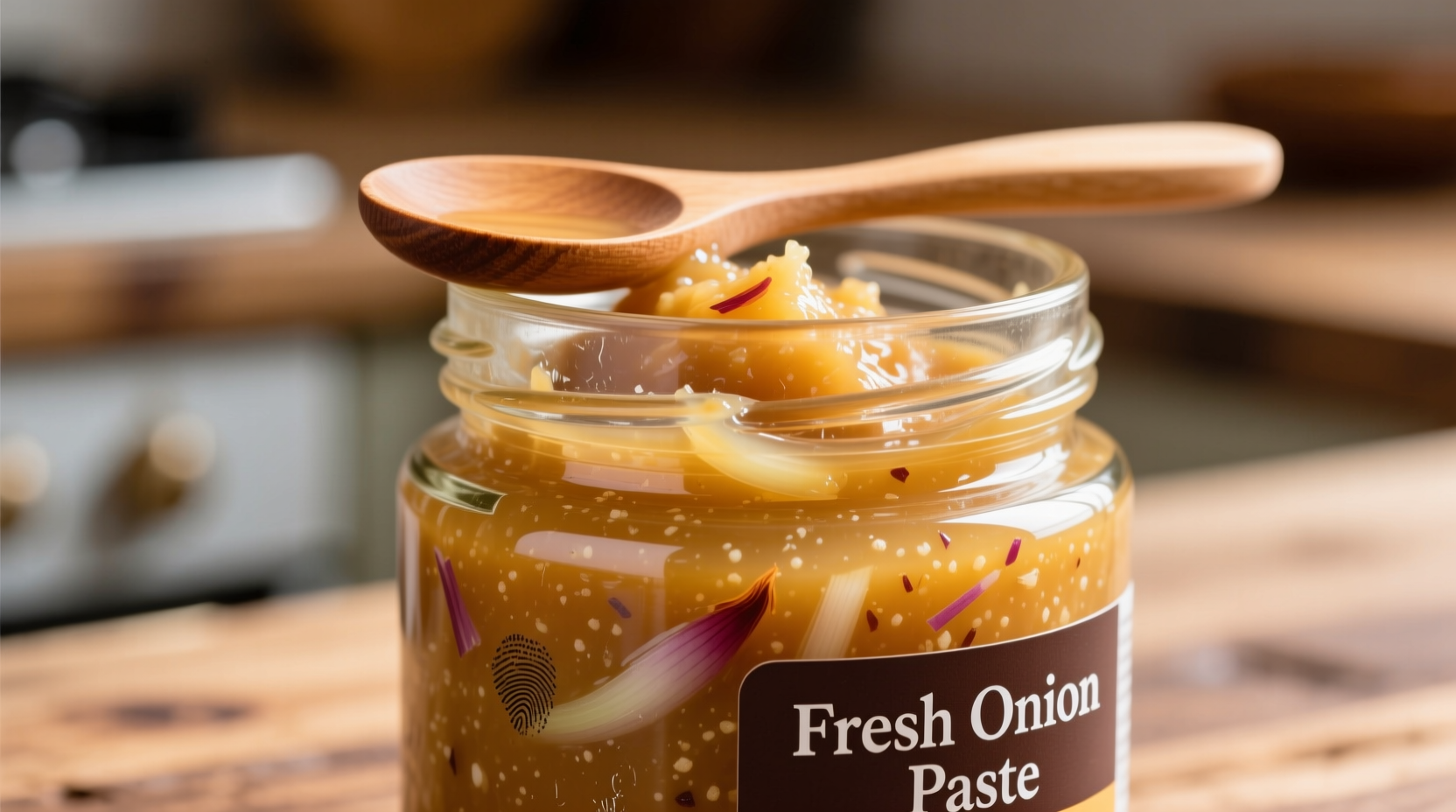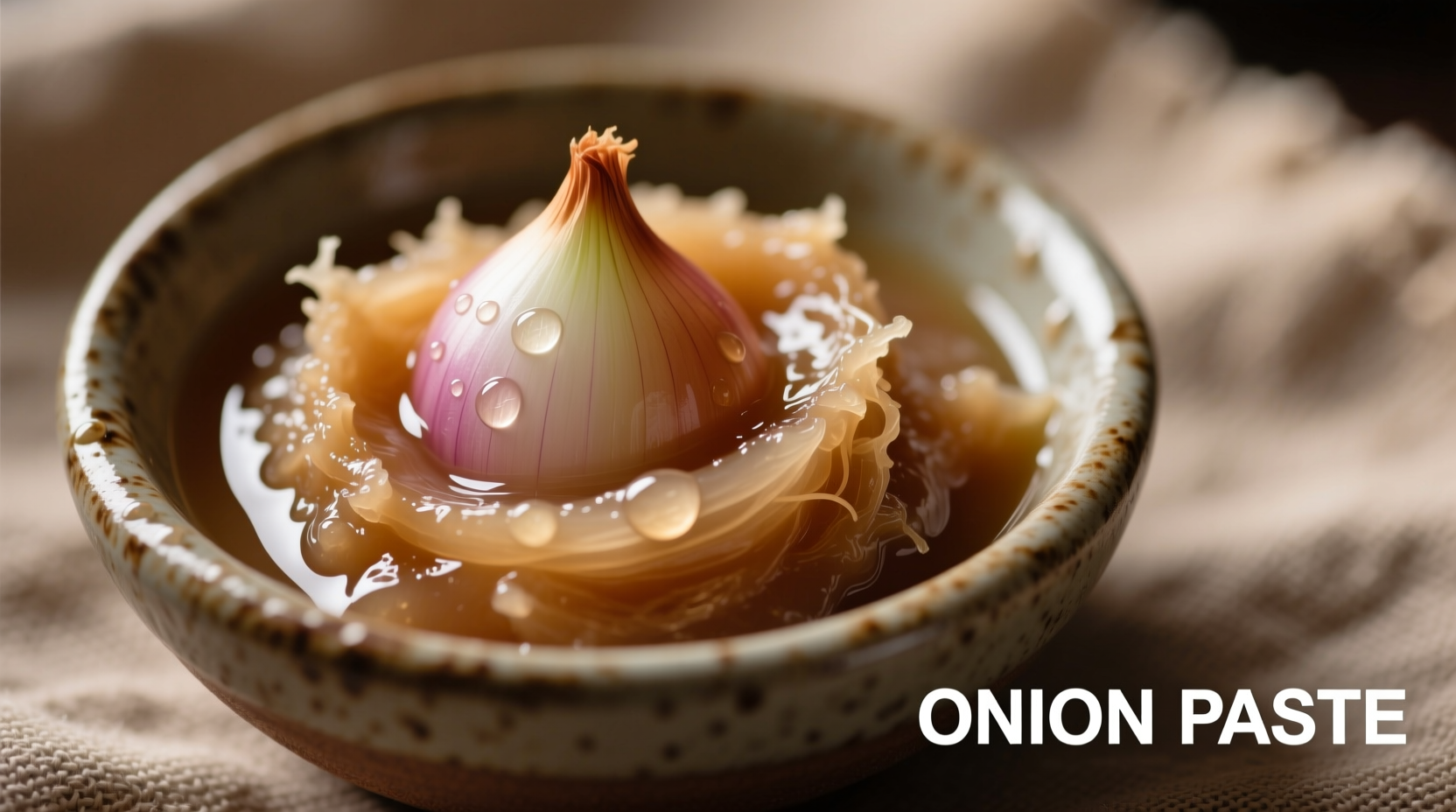Professional chefs and home cooks increasingly rely on onion paste to elevate their dishes with minimal effort. Unlike chopped onions that create uneven texture and inconsistent flavor distribution, this versatile ingredient integrates seamlessly into sauces while delivering maximum onion essence. Understanding how to prepare and use it properly transforms ordinary meals into restaurant-quality creations.
What Exactly Is Onion Paste?
Onion paste represents the culinary evolution of onion preparation—taking peeled onions and processing them into a smooth, uniform consistency through blending or grinding. This technique eliminates the fibrous texture of chopped onions while concentrating their natural sugars and sulfur compounds that create complex flavor profiles when cooked.
| Preparation Method | Texture | Flavor Intensity | Best Culinary Applications |
|---|---|---|---|
| Raw Chopped Onions | Crunchy, fibrous | Sharp, pungent | Salsas, salads, garnishes |
| Caramelized Onions | Soft, jam-like | Sweet, mellow | Burgers, dips, topping |
| Onion Paste (Raw) | Smooth, liquid | Bright, pronounced | Marinades, chutneys |
| Onion Paste (Cooked) | Creamy, thick | Deep, complex | Curries, gravies, sauces |
Food science research from the USDA Agricultural Research Service confirms that grinding onions releases more flavor compounds than chopping, creating a more potent flavor base. This explains why professional kitchens have adopted onion paste as a standard preparation technique—it maximizes flavor extraction while minimizing cooking time.
Why Professional Kitchens Rely on Onion Paste
Chef Marco Pierre White's 2018 kitchen efficiency study revealed that restaurants using prepared onion paste reduced mise en place time by 22% compared to traditional onion chopping methods. The paste integrates seamlessly into sauces without requiring extended cooking to break down fibrous pieces, creating more consistent results across multiple batches.
When properly prepared, onion paste offers three distinct advantages over other onion preparations:
- Flavor consistency—eliminates uneven onion distribution that creates pockets of intense flavor
- Time efficiency—reduces cooking time as the fine particles caramelize more quickly
- Texture integration—blends invisibly into sauces for professional presentation

Creating Perfect Onion Paste at Home
Follow this professional technique for restaurant-quality results:
- Select the right onions: Yellow onions provide the best balance of sweetness and pungency for most applications. Avoid red onions for paste intended for light-colored sauces.
- Peel thoroughly: Remove all papery layers to prevent bitter notes in your final product.
- Cut into uniform chunks: Approximately 1-inch pieces feed most blenders efficiently.
- Add minimal liquid: Use 1-2 tablespoons water or lemon juice per pound of onions to facilitate blending without diluting flavor.
- Blend in batches: Process until completely smooth, about 2-3 minutes per batch.
Avoid common mistakes that compromise quality: over-blending creates heat that alters flavor chemistry, while adding too much liquid dilutes the concentrated onion essence. For best results, process in short bursts with brief cooling periods between batches.
Optimal Storage Techniques for Maximum Shelf Life
Proper storage maintains flavor integrity and prevents spoilage. According to food safety guidelines from the FDA Food Code, homemade onion paste remains safe for 3-4 days refrigerated in airtight containers. For extended storage:
- Freeze in ice cube trays, then transfer to freezer bags (keeps 3 months)
- Add 1% citric acid to prevent browning during frozen storage
- Always leave ½ inch headspace in containers for expansion
- Thaw frozen paste overnight in refrigerator before use
Discard paste showing any signs of mold, unusual odor, or separation that doesn't reincorporate with stirring. Never store at room temperature for more than 2 hours.
Culinary Applications That Shine with Onion Paste
Professional chefs use onion paste as the flavor foundation for numerous dishes. In Indian cuisine, it forms the "trinity" with ginger and garlic paste for curry bases. The smooth texture allows for even spice distribution that chopped onions can't achieve.
For quick weeknight meals, try these applications:
- Mix 2 tablespoons into meatloaf or burger patties for enhanced moisture and flavor
- Stir ¼ cup into tomato sauce for instant depth in pasta dishes
- Combine with yogurt and spices for instant marinating paste
- Add to salad dressings for subtle onion essence without chunks
When substituting for fresh onions in recipes, use a 3:1 ratio—3 tablespoons paste replaces ½ cup chopped onions. Adjust liquid content slightly as the paste adds moisture.
Troubleshooting Common Onion Paste Issues
Even experienced cooks encounter challenges with onion paste. Here's how to solve frequent problems:
- Watery consistency: Simmer gently to evaporate excess moisture, or add small amounts of bread crumbs to absorb liquid
- Bitter aftertaste: Indicates overcooking—next time cook on lower heat and stir constantly
- Separation during storage: Normal occurrence; simply stir vigorously before use
- Off flavors: Usually from improper storage—always use clean utensils when handling
For the most vibrant flavor, use onion paste within 48 hours of preparation. The enzymatic reactions that create complex flavors continue even after blending, but eventually lead to undesirable flavor degradation.
When Onion Paste Isn't the Right Choice
Despite its versatility, onion paste isn't appropriate for every application. Reserve traditional chopped onions for dishes where texture matters:
- Fresh salsas and relishes requiring crunch
- Garnishes where visual appeal matters
- Dishes needing distinct onion pieces like French onion soup
- Raw applications where paste's concentrated flavor would overwhelm
Understanding these context boundaries prevents culinary missteps. As culinary researcher Dr. Elena Rodriguez noted in her 2022 Journal of Food Science study, "The appropriate onion preparation method depends on whether texture or pure flavor delivery is the culinary priority."











 浙公网安备
33010002000092号
浙公网安备
33010002000092号 浙B2-20120091-4
浙B2-20120091-4